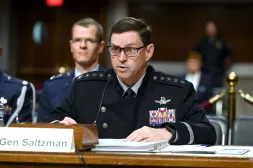Space Force publishes new framework for how it will conduct space warfare

The Space Force released a new document Thursday outlining how the service intends to execute operations — both defensive and offensive — during future conflicts.
Titled “Space Warfighting – A Framework for Planners,” the document provides the service’s most detailed plan to date for conducting warfare “in, from, and to space” as the domain becomes increasingly contested. The framework’s primary goal is to establish a common lexicon for guardians and joint planners focused on counterspace operations. It lists offensive and defensive options the Space Force can take to achieve what it calls “space superiority.”
“It is the formative purpose of the Space Force to achieve space superiority — to ensure freedom of movement in space for our forces while denying the same to our adversaries,” Chief of Space Operations Gen. Chance Saltzman wrote in the framework’s foreword. “We must be prepared to employ capabilities for offensive and defensive purposes to deter and, if necessary, defeat aggressors that threaten our vital national interests.”
The document’s release comes as Secretary of Defense Pete Hegseth has been emphasizing the importance of promoting a “warfighting ethos” across the Defense Department. That rhetoric has trickled down to Space Force leaders, who are now openly discussing the military’s ability to weaponize the space domain through counterspace operations after years of keeping those plans and capabilities behind closed doors.
Lt. Gen. Shawn Bratton, deputy chief of space operations for strategy, plans, programs and requirements, told reporters Wednesday that the new framework represents a shift for the United States’ newest military service towards a more codified strategy and doctrine.
“This space warfighting document is in that vein of the natural maturing of the Space Force, and this one is very specific to space superiority,” Bratton said. “This document is very specific to our core function of space control and how we think about warfighting in space.”
According to officials, counterspace operations will be executed across three mission areas: orbital, electromagnetic and cyberspace warfare. The document also details different offensive and defensive counterspace actions guardians can conduct at the direction of combatant commanders.

For example, offensive actions include “orbital strike,” which can destroy, disrupt or degrade an adversary’s space platforms on orbit either through kinetic or non-kinetic means. The framework also lists “space link interdiction” — options to affect an enemy’s space communications links — and “terrestrial strike” — which focuses on an opponent’s infrastructure on Earth — as offensive options.
The Space Force divides its defensive actions into two groups: active and passive. “Active space defense” includes options to escort friendly satellites on orbit; conduct reactive counterattacks against enemy space systems that pose a threat; and suppress adversary counterspace targeting abilities. The framework lists seven mechanisms for “passive space defense” that aim to proactively protect the Space Force’s capabilities against foes.
Bratton noted the framework isn’t a comprehensive list of what systems the Space Force already has in its arsenal, but will hopefully help frame the service’s discussions on what technologies and systems it will need moving forward.
“I think there are concepts in here that maybe we don’t have capabilities for today, that maybe it’s time to start thinking about those things,” he said. “The document does prod guardians in those areas. Like, let’s find out if there’s a military advantage in space-to-space weapons. Or, let’s find out if there’s a military advantage in other areas.”
Overall, the document attempts to underscore the contributions the Space Force will make to the joint force in future conflicts, as protecting the other services from space-enabled attacks is now considered one of the organization’s core missions.
“The success of the joint force really does depend on the success in the space domain. We have to be able to take away that capability from an adversary, maintain that capability for ourselves — or the whole joint force will suffer,” he said. “It’s a big responsibility. The guardians of the Space Force are going to carry it.”






